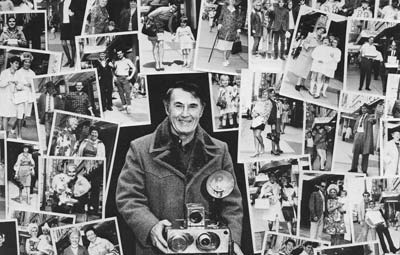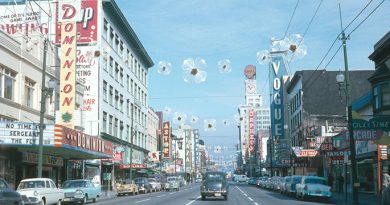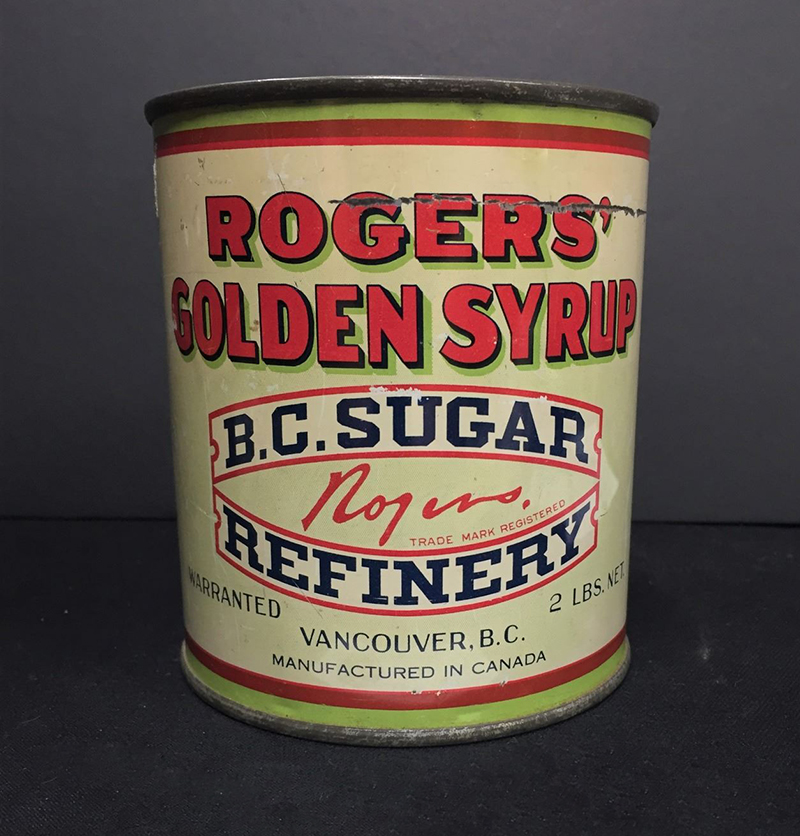Foncie Pulice
On September 27, 1979 street photographer Foncie Pulice took his last picture. Foncie and his Electric-Photo camera had been a familiar sight on city streets for a jaw-dropping 45 years. He’d begun as a 20-year-old away back in 1934 as an assistant to street photographer Joe Iaci, and had taken millions of photographs since. (It is possible Foncie Pulice photographed more people than anyone who ever lived.) “I said I’d retire at 65, and I kept my word,” he said in a November 21, 1979 interview in the Province.

“When I started back in 1934,” Foncie recalled in that interview, “there were six companies in Vancouver, but when we really started to go was during the war. The public couldn’t get film, you see, so the street photographers were all they had. Servicemen would come home on leave, they’d have pictures taken. Families would get together, we’d take their picture. At one time, I was taking 4,000 to 5,000 pictures every day.”
Did he save all those millions of negatives? They’d likely be worth a small fortune now. “I never did,” he said. “I didn’t really think about it at the time. I’d keep ’em for a year, then throw ’em out. I realize now I should have saved them, but it’s too late.” He recalled smilingly that his best customers were local native Indian people. His wife Annie nods in agreement. “The very best,” she said. “I worked in the store, behind the counter and developing, and they’d come in with the slip for the pictures and they’d order half-a-dozen of this one and half-a-dozen of that, and poster-size pictures, all sorts of pictures.”
“I took pictures of their kids, whole families,” Foncie adds. “They’d come in droves. I’d see a bunch of people coming down the street. If there was a native person, I’d wait and take his picture. They were the best.”
People even made appointments for street pictures! “Oh, yes. They’d phone ahead and tell us what time they’d be walking down Granville. Dr. Peter Bell-Irving had members of his family photographed every year. I have shots showing one little tyke in that family growing all the way up to six-foot-five.
“One of the reasons I got into street photography,” Foncie told me during that interview, with a sidelong glance at his wife, Ann, “was because I wanted to meet girls. It was a great way to meet girls. I used to live in the 900 block Seymour and I had a whole wall of phone numbers. Really. Right up on the wall. And beside every number there’d be a little description of the girl. I used to get calls all the time from other fellows. ‘Hey, Foncie, you know all the girls–can you fix us up with dates?”
Ann laughed. She knew about that wall. “You should have saved it,” she told Foncie. “It could go in a museum.”
Well, the wall didn’t go into a museum, but the camera did, a remarkable artifact of a remarkable career. Made of war surplus materials, Foncie’s camera is preserved at the Vancouver Museum. It’s part of their 1950s gallery, and is accompanied by a slew of Foncie’s Fotos.
All across Canada and in other countries there are thousands and thousands of Foncie’s Fotos, showing thousands and thousands of people striding along the street, captured in motion in unposed moments that may be closer to the spirit of the people shown than any carefully composed studio portrait.
Foncie Pulice was the last of the street photographers. He had taken his first street photo in 1934. He would take his last on September 27, 1979. He died January 20, 2003 at age 88, but his work lives on . . . everywhere.

![Foncie Pulice [Image: Vancouver Sun]](https://vancouverhistory.ca/wp-content/uploads/2021/01/8484241.jpg)


![Chinatown [Image: Vancouver Courier]](https://vancouverhistory.ca/wp-content/uploads/2021/01/chinatown-390x205.jpg)